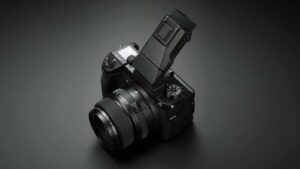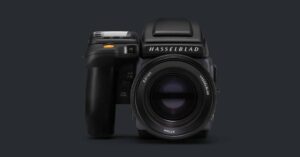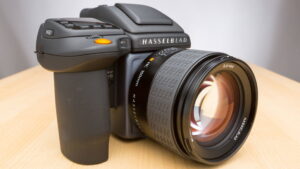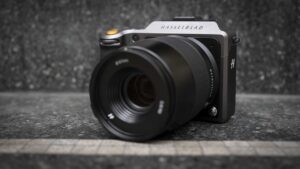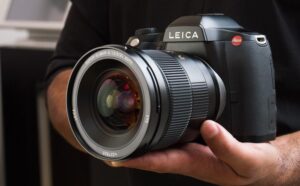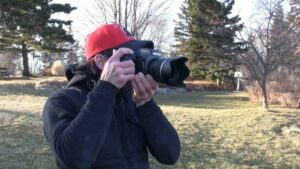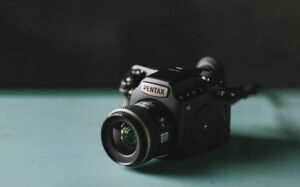Medium format cameras aren’t for everybody: the increased size and often high point of entry make this format untenable for many photographers. The results—better image quality, more vivid colors, and greater dynamic range—all speak for themselves, though, and thanks to companies like Phase One and Mamiya, the medium format is available to seasoned professionals and newcomers alike. This isn’t the best medium format digital camera and the best digital camera around, but it’s an excellent piece of equipment that should fulfill many photographer’s needs.
Why We Like It – Mamiya Digital Camera
Whether you prefer shooting on film, digitally, or dabble in both, the Mamiya 645-AFD III has you covered. This medium format camera works with either a film or digital back, making this camera perfect for a wide variety of projects. What’s more, this Mamiya digital camera isn’t as heavy or bulky as some of its competitors like a Hasselblad digital camera; it instead comes much closer in size to a standard full frame camera.
- Accepts film and digital backs for ultimate versatility
- Super-fast shutter speed from 30 to 1/4000 seconds
- Intuitive design makes learning this camera a breeze
- AF system can’t keep up in low light
- AA batteries drain fast
- Finicky buttons
Related: Check out the Manfrotto 055CX3 Carbon Fiber Tripod review which comes in handy with digital cameras.
Image Quality
Image quality is the name of the game when it comes to medium format digital cameras, and the Mamiya 645-AFD III by Phase One lives up to that reputation. This camera takes stunning photos with exceptionally vivid colors, fantastic depth of field, and a dynamic range that’s to die for. And thanks to this digital camera supporting film backs as well as digital ones, photographers can choose to shoot directly on film if that better fits the aesthetic they’re looking for. A good number of available lenses use a leaf shutter, too, so photographers can rest assured knowing that stellar image quality will remain intact.
Ease of Use
This camera body doesn’t suffer from the size issue that many medium format cameras do, instead more closely resembling a 35mm digital or film camera in size and handling. Several reviewers mention the ease with which they were able to pick up the Mamiya digital camera, citing the intuitive button layout and the ease of switching between a film or digital back. The viewfinder on this camera is also large enough to accommodate comfortable viewing, even for glasses wearers. The buttons for adjusting ISO are small and thus may be difficult to use, but that is a minor problem when compared to the overall ease with which this camera handles.
Battery Life
Unfortunately, the Mamiya 645-AFD III uses six “AA” batteries instead of a rechargeable one like that found on the Hasselblad x1d ii50c. What’s more, this Mamiya digital camera can drain those batteries super quickly. The Mamiya manual claims this camera should last from about 130 to 150 shots on film in a single battery cycle, though some users report batteries only lasting one reel before needing replacement. Whether this is hyperbolic or a fluke remains to be seen, but anyone using this camera would be wise to carry around quite a few spare batteries for their photoshoots.
Related: You might also be interested in our popular Lomography Spinner 360 Camera Review
Durability
In several ways, the Mamiya digital camera is more of a studio camera than an outdoor one. Without any weather sealing to be seen, this camera shouldn’t be subjected to harsh conditions. That’s not to say, however, that this camera isn’t solid: with a die-cast aluminum alloy camera body, the Mamiya 645-AFD III is a well-built machine that doesn’t need to be handled with kid gloves. The body feels incredibly balanced and easy to hold, even for extremely long sessions. Studio photographers are certain to be happy with this Mamiya digital camera.
Value
Though several of the cameras sold by Phase One might be out of an average price range, this Mamiya digital camera can be found for a steal second hand. The AFD camera system also supports a wide variety of quality lenses, so photographers should have little to no issue building a quality setup. This camera is not as powerful as similar Hasselblad digital cameras, but it also doesn’t come at the premium price those cameras do. For studio photographers that want to try a medium format camera and are unworried about extreme low light, the Mamiya 645-AFD III is a worthy choice that won’t break the bank.
Mamiya Digital Camera Wrap Up
In subpar conditions, the Mamiya 465-AFD III doesn’t stack up against its competitors. Autofocus in low light is extremely slow, the “AA” batteries might drain super quickly, and some of the buttons can be, in a word, difficult. But if you want a medium format digital camera to use in a studio, you probably can’t get much better for this price. The image quality is phenomenal, and the versatility of a hybrid film/digital back offers greater artistic freedom than many competitors. If that’s appealing to your style, then this Mamiya digital camera is for you.
